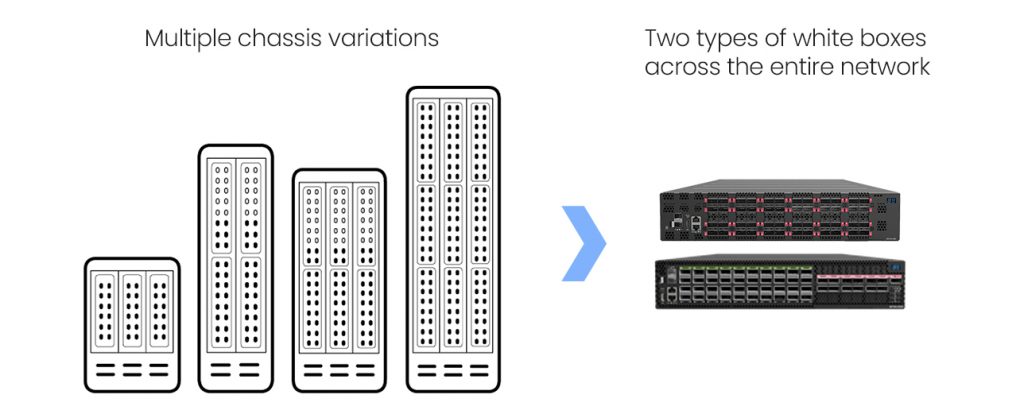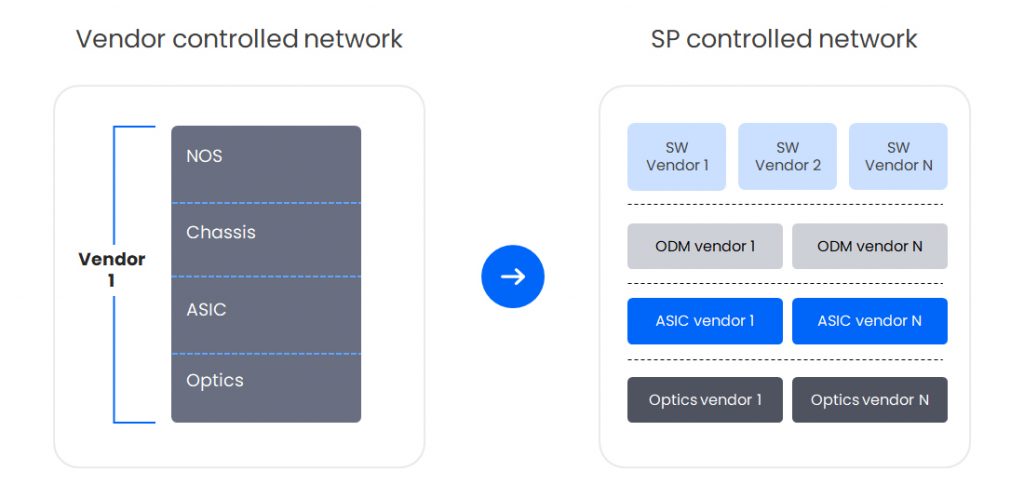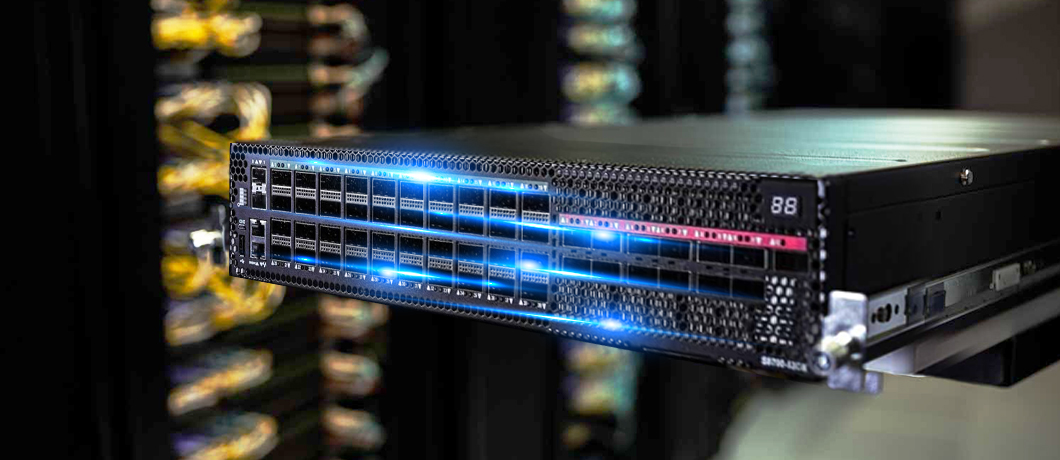|
Getting your Trinity Audio player ready...
|
Service providers today are addressing these challenges by exploring three main areas: redesigning their network architecture, shifting to software-based solutions, and embracing hardware disaggregation. This exploration has led to a modern network infrastructure that utilizes automation and AI tools for more efficient network management, along with a broader range of hardware vendors for greater control over the network.
What is a white box router?
Before we deep dive into the value of white boxes, let’s establish a common understanding of what a white box is. In the networking world, a “white box” typically refers to a generic, low-cost networking device from an original design manufacturer (ODM). These white boxes can be tailored to specific SP requirements and offer a great alternative to proprietary solutions from incumbents. Their key appeal lies in their openness and flexibility, which is why they are often used by SPs and vendors seeking efficient, scalable, and customizable networking solutions at an affordable cost.
Why use white boxes as core building blocks for network architecture?
As we shift toward a new strategy offering more flexibility, elasticity and innovation while reducing cost it’s crucial to rely on the right foundational elements. The use of white boxes as the core building blocks of the new architecture has become increasingly common.
Three main reasons white box networking
#1 Unified network hardware ecosystem
When service providers talk about elasticity, they are referring to the ability to flexibly resize network resources in response to real-time customer demands. This implies viewing the optimal network as a unified platform with shared resources that can be redistributed across network domains as needed. For instance, if one domain’s edge requires additional capacity, resources can be reallocated from a less busy domain. This might seem straightforward, but traditional hardware-based networks, consisting of numerous service-specific boxes, limit this flexibility.
Constructing a network with the same white boxes as building blocks across all domains simplifies the redistribution of resources. Adopting a unified hardware ecosystem drives not only elasticity but also operational simplicity. It reduces the number of boxes that must be maintained and decreases planning and forecasting costs thanks to fewer SKUs.

Move to a unified infrastructure
#2 Architecture flexibility
At DriveNets, we advocate for the Distributed Disaggregated Chassis (DDC), an innovative networking architecture for building networks like cloud. This approach mirrors some of the operational methodologies of a traditional chassis but with enhanced scalability and flexibility. However, as some service providers require different network architecture approaches, it’s essential to prioritize flexibility and agility when building the network.
Let’s review two main architecture examples:
- Large clusters: Many service providers prefer a large DDC cluster due to its virtually limitless elastic scalability, all while functioning as a single network entity. In this architecture, the abstraction layer software consolidates all the white boxes into one shared resource, upon which network functions (NFs) such as core, PE, and aggregation operate. This configuration ensures operational simplicity and consistency regardless of the cluster’s size or complexity.

DDC architecture – The abstraction layer software integrates all white boxes into a single shared resource
- Smaller routing elements: With other service providers, we have observed an alternative strategy where network complexity is transferred from the routers to the network itself. This involves employing smaller routing elements across nearly all network domains and implementing advanced routing techniques. Here, each white box contains a single network function, and the network software orchestrates these white boxes through strategic traffic engineering policies such as segment routing and ECMP. While this method requires a highly skilled operational team, it grants the SP complete control over the network and further simplifies hardware maintenance.

Stand-alone architecture – The network software orchestrates white boxes using advanced traffic engineering
Even by reviewing only those two examples, it is clear that no single architecture suits all network domains and service providers. This highlights the need for a network architecture that can adapt to different requirements. Large, traditional routers are not capable of providing this flexibility. White boxes, on the other hand, can.
#3 Full network disaggregation with white box routers
Traditional integrated solutions, widely adopted by service providers, have limited SPs’ control and flexibility over their networks. The ability to choose multiple vendors has been significantly restricted due to proprietary solutions and complicated integration processes. This has led to SPs depending on too few vendors that control the entire networking ecosystem, from the software and ASICs to the optics equipment.
To regain more SP control over the network, full network disaggregation is needed. This means allowing the service provider full flexibility to select various hardware elements sourced from different suppliers. This multi-level approach not only enhances the flexibility of network function deployment but also mitigates risks associated with vendor lock-in. It enables operators to build a more resilient and adaptive network by combining state-of-the-art hardware and software elements from a diverse supplier ecosystem, tailored precisely to the SPs’ needs.

Service providers can select any software, hardware, ASIC, or optics
How DriveNets and white boxes simplify the network architecture
Traditional networking alternatives may remain a viable option for some service providers. Yet these alternatives may only be viable if an SP can maintain strict long-term cost trajectories while accepting reduced flexibility and elasticity to address emerging requirements.
At DriveNets, our deep, hands-on technical experience and collaborative partnerships with multiple tier-1 service providers have shown us that, despite varying needs, all SPs require a hardware platform that promotes flexibility, elasticity, and cost reduction. Our standard white box offering is designed to meet these requirements, with a focus on the same key benefits mentioned previously:
- Unified hardware ecosystem: From the core to the edge, SPs can use the same two types of white boxes.
- Architecture flexibility: We meet any architecture requirements requested by SPs, whether for a compact yet feature-rich 2.4T standalone white box, or a massive 819T DDC cluster. Moreover, if needed, the SP has the flexibility to remove a white box from a larger cluster and deploy it independently in a separate location, as a fully functional stand-alone box.
- Full disaggregation: DriveNets Network Operating System (DNOS) is hardware-agnostic. This means our software integrates effortlessly with multiple preferred ASIC, ODM, or optics solutions, giving SPs the freedom to choose the best solution/vendor for their needs. Moreover, the standardized white box architecture allows service providers to change even the OS software as needed.
Leveraging the hyperscaler approach to building high-scale networks
We believe that state-of-the-art, high-scale networks should be defined by similar principles used for hyperscaler networks, as they have successfully tackled the challenges faced by service providers. Unified, flexible, and hardware-agnostic white boxes are the core building blocks of such networks.
At DriveNets, our approach goes beyond mere discussion. We are actively implementing networking solutions across several global tier-1 service providers, leveraging a range of white box specifications and architectures to address their specific needs.
After a long build up for SPs to build their networks like cloud, today this approach is already widely recognized and accepted.
Download
DriveNets Total Cost of Ownership White Paper




